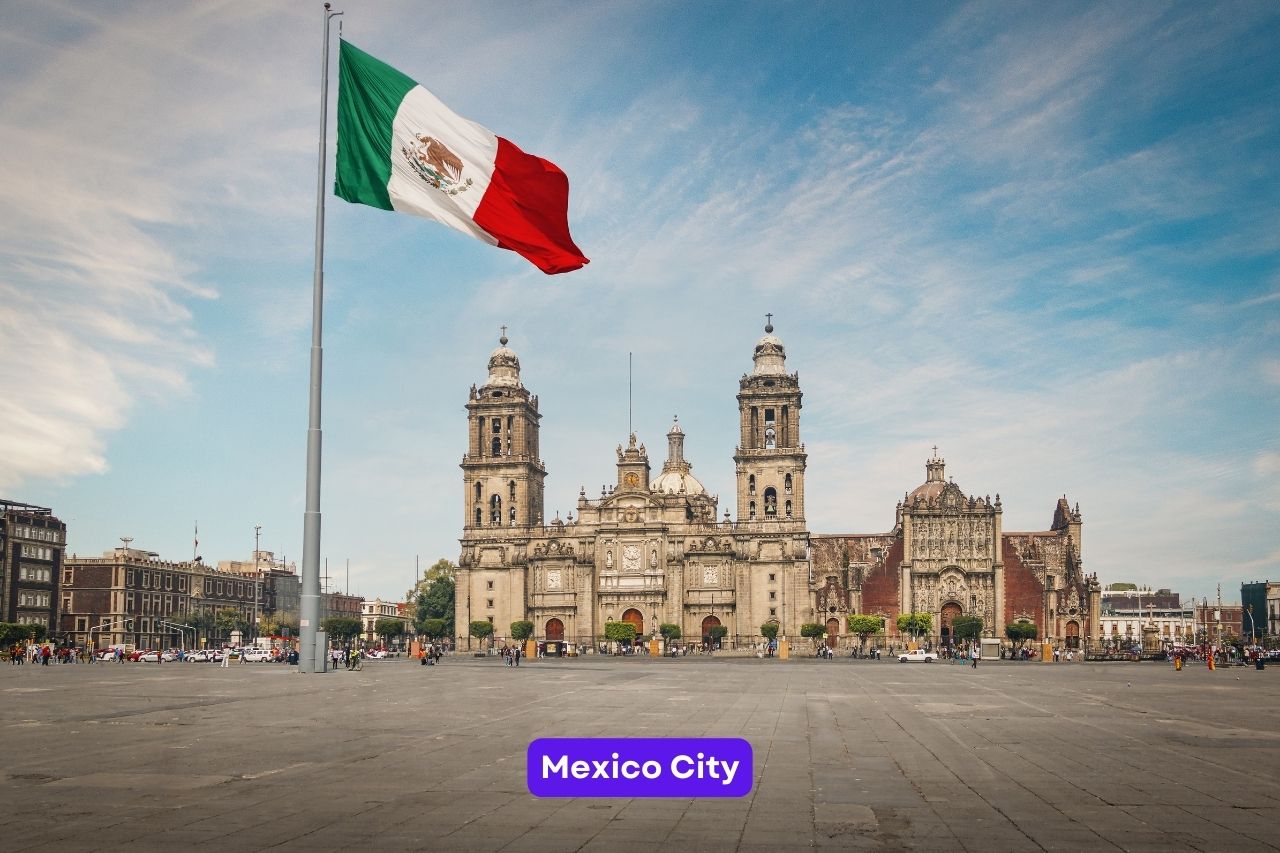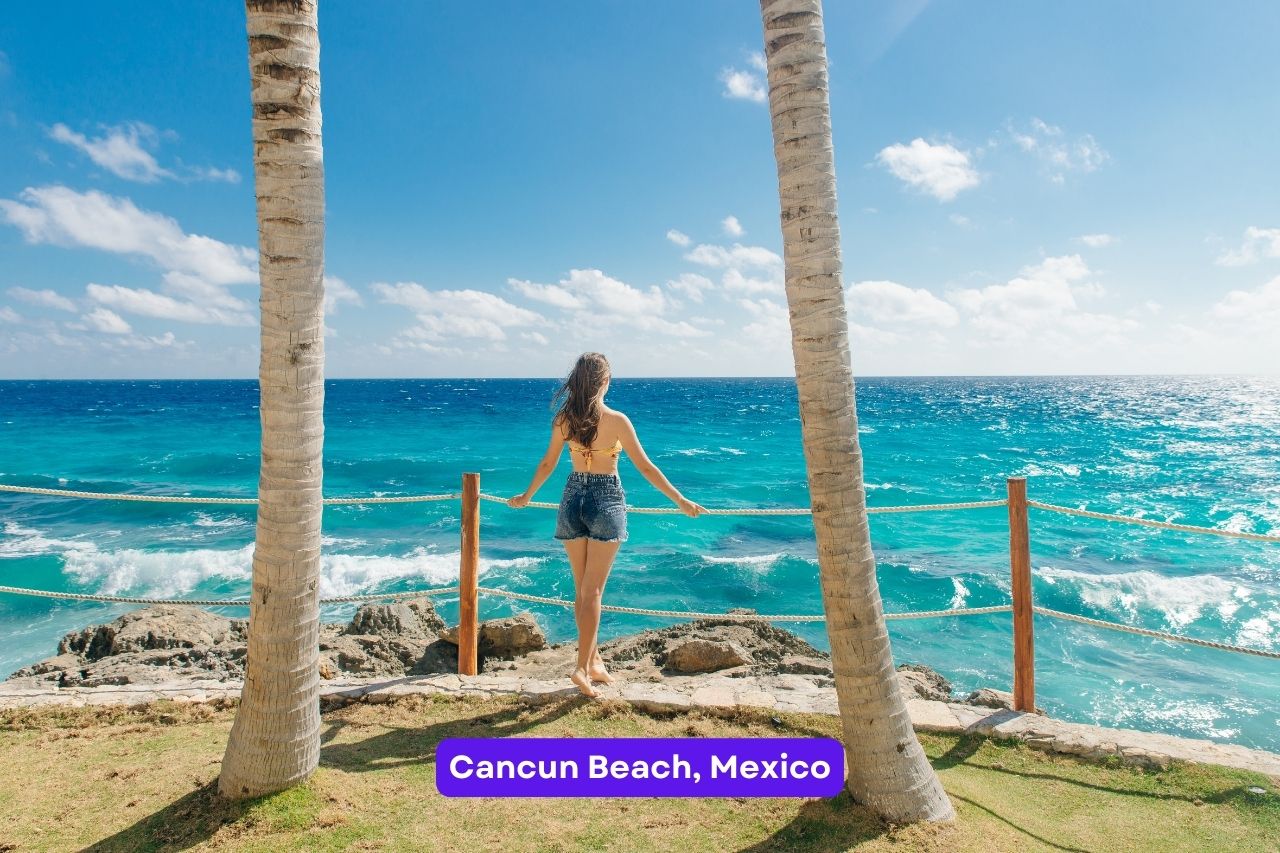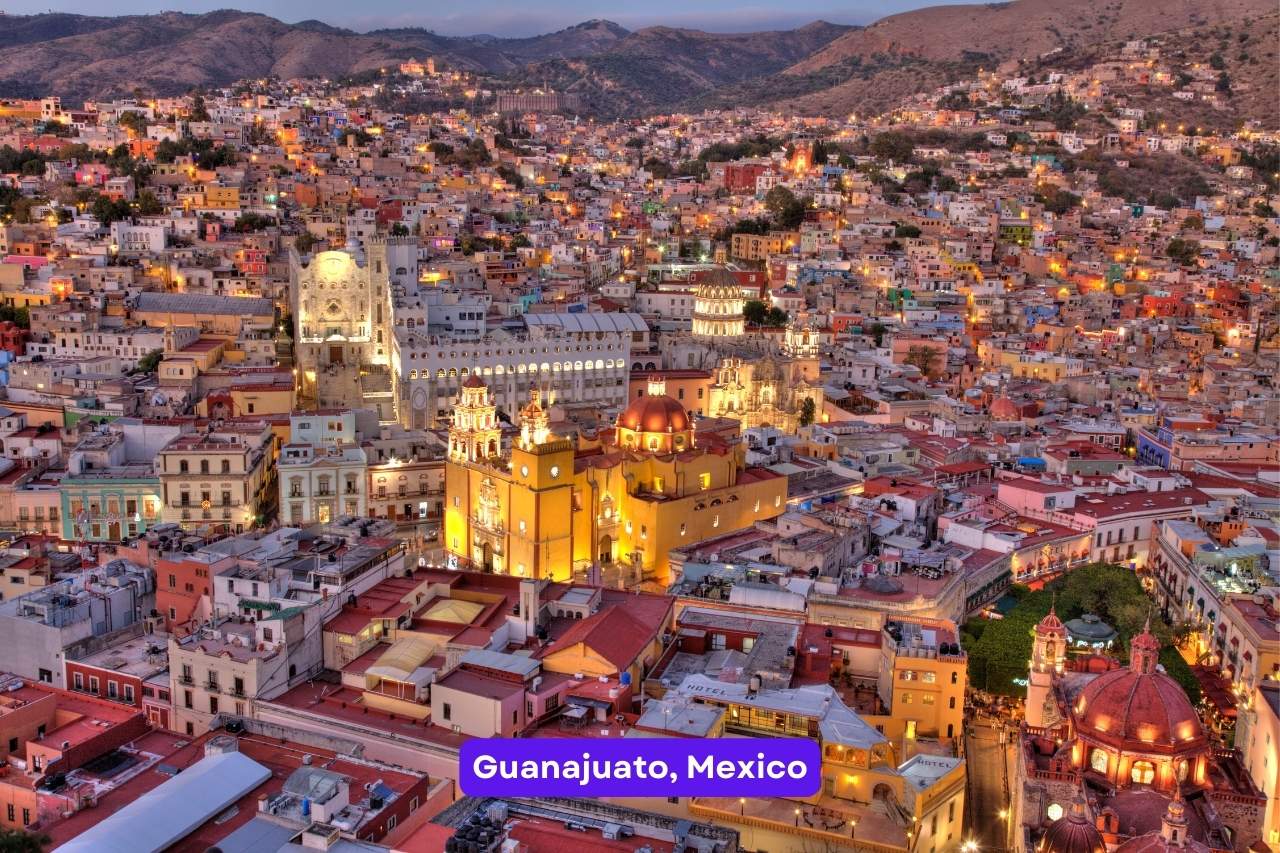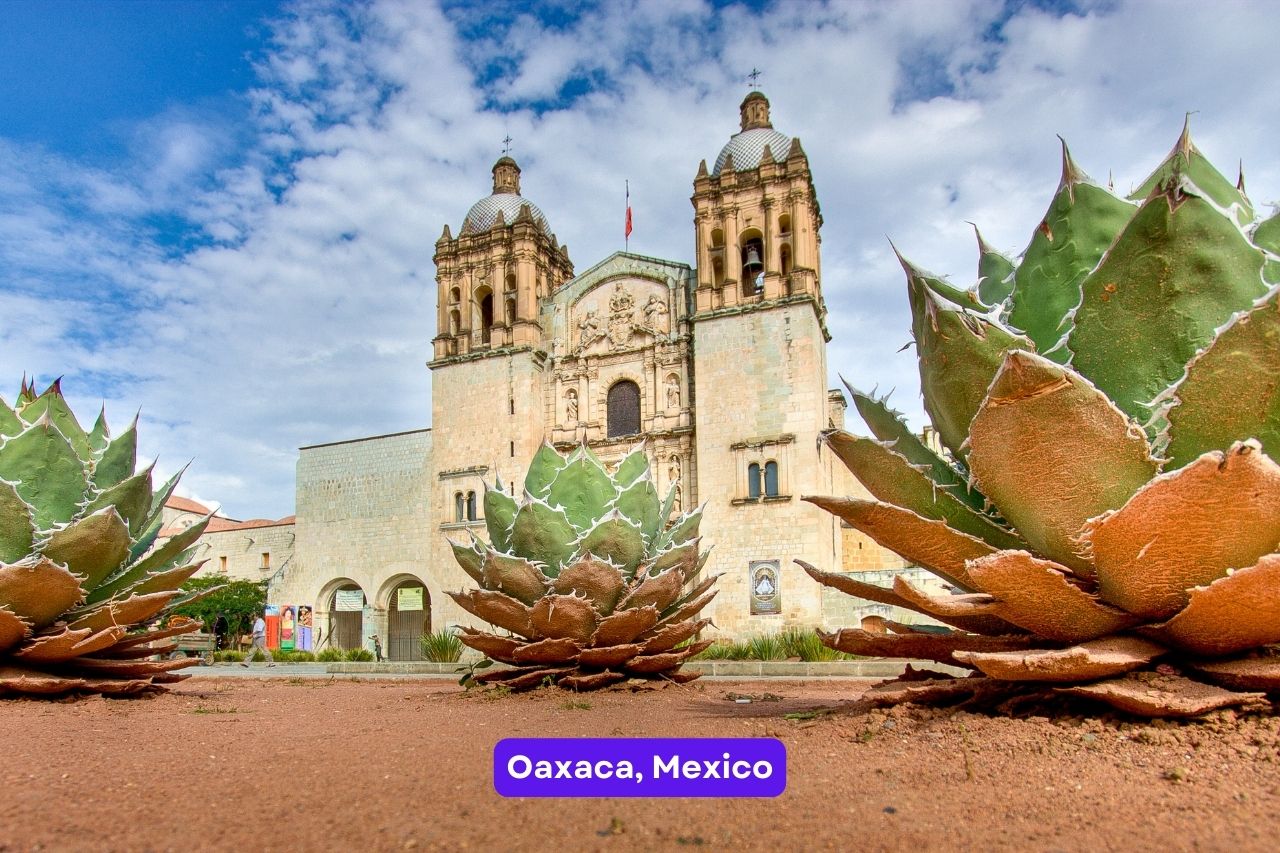Mexico has long been a well-liked holiday spot for travelers from North America, but it’s now gaining popularity among those from Europe who come to take advantage of the country’s breathtaking beauty, endless sunlight, gorgeous sandy beaches, and remarkably rich cultural legacy.
Mexico City
Positioned in the Anáhuac Valley at an elevation of almost 2,200 meters, the city is surrounded by powerful mountain ranges. Notably, two snow-capped volcanoes, Popocatépetl and Iztaccíhuatl, watch over the city from a distance. Mexico City, also known as Ciudad de Mexico, is the nation’s capital and is a whirlwind of stunning architecture, museums, amazing eateries, and lodgings all situated on streets brimming with centuries of history.

Plaza de la Constitución
- Address: P.za de la Constitución S/N, Centro Histórico de la Cdad. de México, Centro, Cuauhtémoc, 06010 Ciudad de México, CDMX, Mexico
- Opening hours: All day
- Entrance fee: Free
Zócalo, or Plaza de la Constitución (Constitution Square), is the pulsating center of Mexico City and the site of the 1813 proclamation of the nation’s first constitution. One of the largest squares in the world, measuring around 240 meters in each direction, Tenochtitlan was conquered and the square was built practically shortly after. The square was utilized for markets and bullfighting arenas in the early colonial era. These days, festivals, parades, and demonstrations take place there.
Palacio de Bellas Artes
- Address: Av. Juarez S/N, Centro Histórico de la Cdad. de México, Centro, Cuauhtémoc, 06050 Ciudad de México, CDMX, Mexico
- Opening hours: 11:00 – 17:00 (except Monday)
- Entrance fee: Free
The Palace of Fine Arts (Palacio de Bellas Artes), one of Mexico City’s most significant cultural icons, is an architectural marvel. This enormous marble structure, which towers over the nearby park, was created by Italian architect Adamo Boari and features Art Nouveau and Art Deco characteristics. It was finished in 1934 and is so heavy that, despite efforts to reduce it, more than four meters have been submerged.
A range of conventional and worldwide dance and opera productions are presented in the palace’s roles as concert hall and opera house. However, a lot of people also come here to see the striking murals created by well-known artists like José Clemente, David Alfaro Siqueiros, and Diego Rivera that cover the building’s interior.
Chapultepec
- Address: Miguel Hidalgo, Mexico City, Mexico
- Opening hours: 05:00 – 18:00 (except Monday)
- Entrance fee: Free
The main park in Mexico City is called Bosque de Chapultepec, and it’s also the largest, spanning more than four square kilometers. These days, the park is well-known for its lakes, athletic facilities, botanic garden, and museums. The National History Museum and the National Museum of Anthropology are located here, among other interesting attractions. The Museum of Modern Art (Museo de Arte Moderno), which debuted in 1964 and is notable for its collection of images and sculptures by Mexican painters from the 19th and 20th centuries, as well as its retrospective examination of Mexican art prior to and throughout the colonial era, are other points of interest.
Museo Nacional de Antropologia
- Address: Av. P.º de la Reforma s/n, Polanco, Bosque de Chapultepec I Secc, Miguel Hidalgo, 11560 Ciudad de México, CDMX, Mexico
- Opening hours: 09:00 – 18:00 (except Monday)
- Entrance fee: 95 MXN
The National Museum of Anthropology, one of the most significant of its kind worldwide, is located in Chapultepec Park and is easily identifiable by the enormous monolithic statue that stands guard at the entrance.
Constructed in 1964, this remarkably effective instance of modern architecture is well-known for its exquisite exhibitions of antique Indian artifacts, particularly in the Central Patio, which is partially covered by a massive stone shelter held aloft by an 11-meter-tall column featuring waterfalls that represent the never-ending cycle of life.
Its extensive collection, which includes artifacts from vanished Indian cultures and information about the daily lives of modern Indian residents of Mexico, is every bit as amazing as the edifice itself. Among the other notables is the National Library of Anthropology, which was established by Emperor Maximilian and started by Lucas Alaman in 1831. It has about 300,000 rare books.
Frida Kahlo Museum
- Address: Londres 247, Del Carmen, Coyoacán, 04100 Ciudad de México, CDMX, Mexico
- Opening hours: 10:00 – 18:00 (except Monday)
- Entrance fee: 320 MXN
The Frida Kahlo Museum in La Casa Azul (The Blue House), the famous Mexican artist’s birthplace and frequented residence throughout her life, is one of the town’s most popular tourist destinations. View some of her most significant paintings here, together with pieces by her well-known husband, muralist Diego Rivera, and mementos from their shared past.
Templo Mayor Museum
- Address: Seminario 8, Centro Histórico de la Cdad. de México, Centro, Cuauhtémoc, 06060 Ciudad de México, CDMX, Mexico
- Opening hours: 09:00 – 17:00 (except Monday)
- Entrance fee: 95 MXN
Many of the Aztecs’ significant historical sites have been discovered and restored in subsequent years, despite the general devastation caused by their demise. The most significant location is Templo Mayor, which houses the ruins of the Great Temple of Tenochtitlan. It is here that the first artifact was found in 1978 and is a beautifully sculpted round disk that weighs eight and a half tons and measures more than three meters in diameter.
The site of the temple has been rebuilt eleven times by the Aztecs and their predecessors, according to additional excavations that have uncovered the skulls of sacrifice victims and the summit platform of an earlier pyramid with well-preserved temple walls.
A stroll past the aristocratic “winged warriors” precinct is a highlight of a visit; here, remnants of multicolored relief-decorated homes have been discovered, along with proof of the original paint job.
Chapultepec Castle
- Address: Bosque de Chapultepec I Secc, Miguel Hidalgo, 11580 Mexico City, Mexico
- Opening hours: 09:00 – 17:00 (except Monday)
- Entrance fee: 95 MXN
One of the most popular tourist destinations in Mexico City is Chapultepec Castle, which is perched on a hill and overlooks a park. There are no other royal palaces occupied by kings in North America. There are rumors that the history of the castle is laced with witchcraft, covert plans to topple the government, and executions. The fortress was eventually abandoned during the War of Independence rumors, but it would soon honor six young lads known as the Niños Héroes (Hero Children). During the Mexican-American War, these young soldiers defended the Chapultepec Castle before succumbing to their wounds at the Battle of Chapultepec in 1847. Chapultepec Castle welcomes visitors who wish to explore its impressive findings and history while admiring its magnificent architecture and design!
Museo Soumaya
- Address: Blvd. Miguel de Cervantes Saavedra, Granada, Miguel Hidalgo, 11529 Ciudad de México, CDMX, Mexico
- Opening hours: 10:30 – 18:30
- Entrance fee: Free
A visit to the Museo Soumaya is a must-do when visiting Mexico City. One of the richest men in the world, Carlos Slim, founded this future architectural mind-meld and named it after his late wife, Soumaya. The 170,000 square foot, silvery, reflective structure is an architectural marvel in and of itself, with an hourglass-like center squeeze and an angular shape akin to a ship’s hull. More than 66,000 pieces of art spanning 3,000 years may be found inside, including pieces by Salvador Dali and Tintoretto as well as sculptures from Mesoamerica.
Basilica of Our Lady of Guadalupe
- Address: Fray Juan de Zumárraga No. 2, Villa Gustavo A. Madero, Gustavo A. Madero, 07050 Ciudad de México, CDMX, Mexico
- Opening hours: 06:00 – 21:00
- Entrance fee: Free
The Roman Catholic Basilica of Our Lady of Guadalupe, also known as the Basílica de Nuestra Señora de Guadalupe, is said to have drawn its initial pilgrims when it opened in 1531. Every year, millions of people attend and offer prayers, especially on December 12th, which is the feast day.
The site, which was constructed next to the hill where the Virgin Mary is supposed to have appeared, is made up of a collection of buildings that face a big public area that is decorated with a variety of intriguing modern sculptures, one of which is a large concrete cross that has a clock and chime that is distinctive.
Highlights include the magnificent altarpiece honoring Mary in the Old Basilica from the 16th century and the new Basilica de Guadalupe, which was constructed in 1976 and is distinguished by its angular, contemporary design.
Mexico City Metropolitan Cathedral
- Address: P.za de la Constitución S/N, Centro Histórico de la Cdad. de México, Centro, Cuauhtémoc, 06000 Ciudad de México, CDMX, Mexico
- Opening hours: 09:00 – 17:30
- Entrance fee: Free
One of the biggest and oldest churches in the Western Hemisphere, the huge Mexico City Metropolitan Cathedral (Catedral Metropolitana de la Asunción de María) dominates Zócalo Square. This enormous building made of gray sandstone and basalt was constructed over the course of 250 years, starting in 1525 and ending on top of the site of an ancient Aztec temple complex.
Despite the two neoclassical towers and certain other elements, the façade’s huge twisted columns give off a very Baroque vibe. The 1793 addition of the bell towers and the 1813 statues of Charity, Hope, and Faith atop the clock tower are notable elements.
The inside of the cathedral displays a blend of styles as well. Of special note is the exquisitely carved Altar of the Kings (Altar de los Reyes) from 1739, which is dedicated to the Assumption (Asunción de María) and features an amazing devotional artwork.
A church housing the remains of Mexican Emperor Agustin de Iturbide and the crypt housing the burial of numerous archbishops of the city, including the first occupant of the office and renowned Indian scholar Juan de Zumárraga, are also noteworthy.
Monument to the Revolution
- Address: Pl. de la República s/n, Tabacalera, Cuauhtémoc, 06030 Cuauhtémoc, CDMX, Mexico
- Opening hours: 12:00 – 20:00 (Monday – Thursday) | 12:00 – 21:00 (Friday – Saturday) | 11:00 – 20:00 (Sunday)
- Entrance fee: 150 MXN
One important monument honoring the Mexican Revolution in Mexico City is the Monument to the Revolution. It is well situated in downtown Mexico City’s Plaza de la República, close to the intersection of Avenida de los Insurgentes and Paseo de la Reforma.
The building is not just a memorial but also a mausoleum commemorating the heroes of the 1910 Mexican Revolution. Francisco “Pancho” Villa, Venustiano Carranza, Plutarco Elías Calles, Lázaro Cárdenas, and Francisco I. Madero are a few of these. This gives the monument more historical and cultural relevance, making it a worthwhile visit for anybody with an interest in Mexican history.
Paseo de la Reforma and The Angel of Independence
- Address: Av. P.º de la Reforma, Juárez, Cuauhtémoc, 06600 Ciudad de México, CDMX, Mexico
- Opening hours: All day
- Entrance fee: Free
This lovely avenue stretches to a width of sixty meters, with a nice green strip holding monuments and busts of several national heroes in the center. This magnificent avenue, which was designed during the reign of Emperor Maximilian, is now primarily known as a bustling entertainment and shopping district, but it also houses several important attractions. The most notable of these is the massive Independence Monument (Monumento a la Independencia), also called “El Angel” because of the figure of a winged goddess of victory that stands atop its tall 36-meter column. The Mausoleum, which houses numerous skulls of some of the most significant historical people in the nation, is in addition to its exquisite monuments of the heroes of the independence movement.
Alameda Central
- Address: Av. Hidalgo s/n, Centro Histórico de la Cdad. de México, Centro, Cuauhtémoc, 06010 Ciudad de México, CDMX, Mexico
- Opening hours: All day
- Entrance fee: Free
Originally designed as the location of a bustling Aztec market, Alameda Central is a shaded, immaculately maintained park with numerous magnificent fountains and sculptures that dates back to 1592. Even now, during the holidays, when it is exquisitely decked and illuminated, it is a busy place. The magnificent Palacio de Bellas Artes, which is next to the park, is the venue for significant art exhibitions in addition to musical and dramatic events.
The House of Tiles
- Address: Av Francisco I. Madero 4, Centro Histórico de la Cdad. de México, Centro, Cuauhtémoc, 06500 Cuauhtémoc, CDMX, Mexico
- Opening hours: 07:00 – 01:00
- Entrance fee: Free
Casa de los Azulejos, often known as the beautiful House of Tiles, is located across from the charming Church of San Francisco. It was first constructed in 1596 and has a façade embellished with beautiful blue and white Puebla tiles 150 years later by the Conde del Valle de Orizaba.
After José Clemente Orozco created murals on the stairwell walls in 1925, it gained even greater notoriety. Surrounded by one enormous piece of art, the House of Tiles is now a restaurant and a memorable place to eat al fresco in the building’s stunning courtyard.
Cancun
Greetings from the most famous paradise in Mexico. Situated on a 13-mile-long, 396-meter-square L-shaped island that lies off the north coast of the Yucatan peninsula, Cancun is arguably the most well-known travel destination in all of Mexico. A causeway connects the popular tourist destination with the mainland, where the contemporary city of Cancún is situated. The mainland is a bustling center with many fascinating sights to see, provided you can resist the beaches.

Chichen Itza
- Address: 97751 Yucatan, Mexico
- Opening hours: 08:00 – 16:30
- Entrance fee: 95 MXN
Few tourists will want to pass up the opportunity to spend at least a portion of their trip sightseeing at one or more of the more significant Mayan ruins that are close to Cancún. Chichén Itzá, one of Mexico’s largest and best-restored ancient sites, is three hours west of the beaches and a favorite destination for day visits. This UNESCO World Heritage Site, which was settled by the Mayans more than a millennium ago, is home to numerous well-known Chac-mool figures as well as significant structures like the 30-meter-tall El Castillo, one of the most well-known pyramids in the nation.
Tulum
- Address: Zona Hotelera Tulum, 77765 Tulum, Quintana Roo, Mexico
- Opening hours: 08:00 – 17:00
- Entrance fee: 95 MXN
If you’re short on time, Tulum is a better option; it’s only 90 minutes south. Along with its towering, wide walls, Tulum is recognized for being the only known fortified Mayan coastal town and for being perched atop a cliff. Of particular note is its Temple of the Frescos, which features sculptures and reliefs of sitting individuals wearing ornate headdresses. Situated on the edge of a cliff with a breathtaking view of the sea, the Castillo is the largest and most well-known building on the site. This whole-day trip also includes transportation, a multilingual guide, all equipment, a traditional Mexican lunch, and an educational jungle stroll.
Playa Delfines
- Address: Punta Nizuc, Blvd. Kukulcan 17, Zona Hotelera, 77500 Cancún, Q.R., Mexico
- Opening hours: All day
- Entrance fee: Free
The unspoiled beauty of Playa Delfines, a favored spot for locals and tourists seeking adventure off the usual road, provides a respite from Cancun’s bustle. A pleasant diversion from the packed beaches and busy nightclubs that Cancun is famous for is Dolphin Beach (Playa Delfines). This calm length of sand is suitable for a leisurely stroll, surfing, or just lounging. It is situated at one of the city’s highest points, just beyond the hotel zone. Picture-perfect broad vistas may be seen from this serene location.
Captain Hook Cancun
- Address: Blvd. Kukulcan km.5-Km 5, Kukulcan Boulevard, Zona Hotelera, 77500 Cancún, Q.R., Mexico
- Opening hours: 08:00 – 20:00
- Entrance fee as follows
| Type of tour | Category | Fee (MXN) |
| Surf & Turf Dinner | Child 02-11 years old | 1,045 |
| Adult | 2,090 | |
| Lobster Tail Dinner | Child 02-11 years old | 950 |
| Adult | 1,900 | |
| New York Steak Dinner | Child 02-11 years old | 855 |
| Adult | 1,710 | |
| Vegetarian Dinner | Child 02-11 years old | 760 |
| Adult | 1,520 | |
| Grilled Chicken Dinner | Child 02-11 years old | 760 |
| Adult | 1,520 |
Enjoy a fun-filled family evening on a Captain Hook pirate ship in Cancun. The evening includes a buffet dinner served by seasoned sailors, dancing on the deck, and drinking from an open bar. Replica Spanish galleons from the eighteenth century sail the Caribbean, while “pirates” regale the audience with stories of their previous adventures and spectacular sword fights.
The Captain Hook fleet consists of three ships, El Galleon I, El Bucanero II, and Black Pearl, each measuring 93 feet (28 meters) and accommodating up to 285 passengers. Despite their vintage appearance, the vessels are completely modern, with air conditioning, sophisticated sound and video equipment, and other amenities. Dinner is included and includes baked potato, rice, salad, veggies, and dessert. Options include steak, chicken, lobster, or a surf-and-turf combination.
Ventura Park
- Address: Blvd. Kukulcan Km. 25, Zona Hotelera, 77500 Cancún, Q.R., Mexico
- Opening hours: 10:00 – 17:00 (except Monday, Tuesday)
- Entrance fee as follows
| Type of ticket | Category | Fee (MXN) |
| Fun Pass Ventura Park | Child 05-11 years old | 49 |
| Adult | 59 | |
| Platinum Pass Ventura Park | Child 05-11 years old | 59 |
| Adult | 69 | |
| VIP Pass Ventura Park | Child 05-11 years old | 164 |
| Adult | 209 |
This renowned family-friendly location is a beachfront amusement park close to Cancún. Waterslides, ziplines, dolphin encounters, go-karts, a state-of-the-art arcade, and more can be found in each of its sections, which include Wet’n Wild, Underworld, Aah!Ventura, Grand Prix, Fun World, and Dolphinaris.
Rio Secreto Nature Reserve
- Address: Carretera Federal Libre Chetumal – Puerto Juárez Km 283.5, Ejido Sur, 77712, 77712 Playa del Carmen, Q.R., Mexico
- Opening hours: 09:00 – 15:00
Rio Secreto, often known as the “Secret River,” is a network of caves in Mexico formed by the course of an old underground river. Although the reserve is best known for its sizable partially submerged cavern, which is a well-liked diving location, you can also swim in the river, explore spooky tunnels, and take in the stunningly colorful stalagmites and dripping stalactites. You may also explore the famed Crystal Caves, take a tour of the underground river, and discover the history of the old Maya legends.
Mayan Ruins of Coba
Address: Coba, Quintana Roo, Mexico
The remains of Coba (Zona Arqueológica de Cobá), an ancient Maya city regarded as one of the most significant towns in Mesoamerican history, are located in the center of Mexico’s Yucatan Peninsula. At the height of its development, between AD 500 and 900, Coba supported 50,000 people and served as the hub of the intricate Maya road network. Visitors can see the already-found remnants of these sacbes, or stone causeways, as well as several carved and engraved monuments, even though the entire site is still being excavated.
Isla Mujeres
Address: Quintana Roo, Mexico
The charming Isla Mujeres, sometimes known as the Island of Women, is another location that is strongly connected to Cancún. This long, skinny island, which is only seven kilometers long and 650 meters wide, is particularly popular among surfers for the larger waves experienced on its east coast, while divers love the abundant marine life surrounding the numerous coral reefs of Garrafon Natural Reef Park. It is located about 13 kilometers from the mainland and is only a short hydrofoil ride from the pier at the convention center (Cancún Center).
Guanajuato
Whether as a permanent resident or as a vacation spot, non-Mexicans have long flocked to Guanajuato, the charming old city in the center of Mexico and the state of the same name. In addition to a plethora of first-rate museums and art galleries, this charming UNESCO World Heritage Site is home to churches constructed of pink or green sandstone, colonial-era homes, and numerous little plazas.

Monumento Al Pipila
- Address: Cerro de San Miguel S/N, Zona Centro, 36000 Guanajuato, Gto., Mexico
- Opening hours: All day
- Entrance fee: Free
Juan Jose Martinez, also referred to as El Pípila, is the hero who earned the city its independence in 1810 by breaking through the Alhondiga gates. This historic monument is dedicated to him. The statue’s distinctive torch helps people distinguish it, having been constructed in 1939 from pink quarry.
Located on a hill, the statue provides an amazing 360-degree view of the city and is reachable by foot, public transportation, or the city’s cable car. Just before sunset, when the city is drenched in breathtaking natural light, is the ideal moment to see Monumento al Pipila.
Alhóndiga de Granaditas Regional Museum
- Address: C. Mendizábal 6, Centro, 36000 Guanajuato, Gto., Mexico
- Opening hours: 10:00 – 18:00 (Tuesday – Saturday) | 10:00 – 15:00 (Sunday)
- Entrance fee: Free
One of the biggest and most intriguing of Guanajuato’s old secular structures is the Alhóndiga de Granaditas, which was finished in 1809. Originally constructed as a granary and temporarily utilized as a marketplace, the structure was used as a fortress by the Spanish and their loyalist allies. Miguel Hidalgo’s men eventually overran it, resulting in the first defeat of the colonialists who had governed Mexico for generations. A funicular railway at a hillside park overlooks the city, where a statue honoring Hidalgo’s role in the incident stands.
With its exhibits on the war and Hidalgo’s execution—in which his head and the heads of his fellow countrymen were displayed for all to see—the structure is currently home to the Guanajuato Regional Museum. Apart from showcasing items from the colonial era, the museum also possesses an extensive array of Pre-Columbian relics.
Museum of the Mummies of Guanajuato
- Address: Explanada del Panteón Municipal s/n, Centro, 36000 Guanajuato, Gto., Mexico
- Opening hours: 09:30 – 18:00
- Entrance fee as follows
| Type of ticket | Category | Fee ($) |
| Mummy Museum | Child over 06 years | 56 |
| Student | 56 | |
| Adult | 97 | |
| Senior over 60 years old | 28 | |
| Death Cult Museum | 18 | |
| “Scare” Package: Mummies Museum and Death Cult | 115 |
The Mummies of Guanajuato, despite their graphic nature, have become a major draw for tourists to the city and are a significant cultural phenomenon that is linked to regional customs and traditions. The Mummies Museum (Museo de las Momias de Guanajuato) was established in 1865 after the naturally mummified corpses of people who perished during a cholera outbreak in the mid-19th century were removed from the ground due to nonpayment of burial taxes by their family.
The fact that some of the interred were still alive at the time, as evidenced by the occasionally frightful looks on their faces, adds to the fairly gory display. The museum also claims to hold the world’s smallest mummy, a fetus, in addition to a few dressed mummies.
Diego Rivera’s House Museum
- Address: Positos 47, Zona Centro, 36000 Guanajuato, Gto., Mexico
- Opening hours: 10:00 – 16:30 (except Monday)
- Entrance fee: $30
A trip to The Diego Rivera House and Museum is a must-do whilst in Guanajuato. Diego Rivera Marin, his daughter, guided the building’s restoration in the 1970s, and in 1975 it was officially designated as the Diego Rivera House Museum. Inside, guests will find chambers that have been meticulously restored to depict the formative years of Rivera’s life. Portraits of Frida Kahlo and his mistress Dolores Olmedo are among the artworks. His pictures, enlargements of his most well-known murals, and pencil and ink drawings are among his other creations.
Museo Ex Hacienda San Gabriel de Barrera
- Address: KM 2.5, Guanajuato- Marfil, El Cerrito, 36050 Guanajuato, Gto., Mexico
- Opening hours: 09:00 – 18:00
- Entrance fee: 35 MXN
Situated on the outskirts of Guanajuato, the Ex-Hacienda San Gabriel de Barrera is a museum set in a former colonial residence surrounded by seventeen beautifully planted gardens. Constructed in the latter part of the 17th century, the edifice served as the magnificent mansion of Captain Gabriel de Barrera, a descendant of the initial La Valenciana silver mining magnate.
The building, with its opulent period furniture, was turned into a museum in 1979 and provides an insight into the Vice-Regal era’s aristocratic lifestyle. Take a leisurely stroll around the themed gardens, which include the Mexican, English, and Oriental gardens.
Oaxaca
One of Mexico’s most stunning towns, Oaxaca is located in the center of the state of the same name and is bordered by the tall mountains of the southern Sierra Madre as well as dense tropical vegetation. This UNESCO World Heritage Site, which features an appealing blend of Spanish and Indian elements, provides lots of wonderful chances for sightseeing and worthwhile locations to explore.

Templo de Santo Domingo de Guzmán
- Address: C. Macedonio Alcalá s/n, RUTA INDEPENDENCIA, Centro, 68000 Oaxaca de Juárez, Oax., Mexico
- Opening hours: 09:00 – 19:00 (Monday – Friday)
- Entrance fee: Free
Founded in 1575 by the Dominicans, the magnificent Church of Santo Domingo de Guzmán (Templo de Santo Domingo de Guzmán) is well worth the time to visit. Built with two-meter-thick walls to nearly totally prevent seismic damage, this remarkable structure, together with the surrounding monastery that houses the must-see Cultural Centre of Oaxaca, is an outstanding sight.
Known for the many statue-filled niches that line its magnificent Baroque façade, this expansive church complex features inner walls and ceilings adorned with an abundance of golden embellishments and vibrant sculptures, giving the impression that it is more of a palace than a church. The numerous rustic figures that give the nave and chapels a distinctly Mexican feel, however, somewhat counteract this.
Moreover, the ceiling above the entry features a vine with 34 portraits growing from its golden branches and leaves that represent the family tree of St. Domingo de Guzmán, the founder of the Dominican order who passed away in 1221.
Some highlights are its eleven chapels, the most magnificent and largest of which is the Rosary Chapel (Capilla de la Virgen del Rosario), complete with its own sacristy and choir, and an ornately adorned altar featuring an image of the Virgin Mary that is regarded as a jewel of Mexican Rococo architecture.
Jardín Etnobotánico de Oaxaca
- Address: Reforma Sur n, RUTA INDEPENDENCIA, Centro, 68000 Oaxaca de Juárez, Oax., Mexico
- Opening hours: 10:00 – 12:00 & 17:00 (Monday – Friday) | 10:00 – 12:00 (Saturday)
- Entrance fee: 50 MXN
Oaxaca Ethnobotanical Garden (Jardín Etnobotánico de Oaxaca) is a must-see destination that is situated next to the Church of Santo Domingo de Guzmán on roughly 2.5 acres. It is a great place to visit in the summer and spring when the gardens are in full bloom. Highlights include a large range of native species, a medicinal plant area, and species that have been utilized in traditional cuisines for ages.
Zona Arqueológica de Monte Albán
- Address: Ignacio Bernal S/N, 71233 San Pedro Ixtlahuaca, Oax., Mexico
- Opening hours: 09:00 – 15:30
- Entrance fee: 95 MXN
For 2,500 years, a variety of ethnic groups used the 40 square kilometer historic village of Monte Albán (Zona Arqueológica de Monte Albán) as a significant site of devotion.
Arising on an artificial platform 400 meters above the Oaxaca Valley, the ruins’ center may be the oldest and most remarkable Pre-Columbian monument in Latin America. In its prime, the city—which dates back to the sixth century BC—had 35,000 residents.
Highlights include the magnificent Grand Square (Gran Plaza), which is the focal point of the archaeological remains and spans 200 meters by 3,300 meters. Other notable features are the Ball Court (Juego de Pelota), several enormous pyramids, and a palace featuring a cruciform tomb and inner courtyard.
Basílica de Nuestra Señora de la Soledad
- Address: Av. de la Independencia 107, CALZADA MADERO, Centro, 68000 Oaxaca de Juárez, Oax., Mexico
- Entrance fee: Free
One of the best religious buildings in the city, the Basilica of Our Lady of Solitude (Basílica de Nuestra Señora de la Soledad), was built between 1682 and 1690 using green cantera, a local stone. It is devoted to the patron saint of Oaxaca.
It is remarkable not only for its lovely atrium made of limestone blocks and encircled by a covered walkway, but also for its representation of the Virgen de la Soledad, who wears a big pearl on her forehead and a black velvet robe adorned with gold and other precious stones. The old Baroque organ, which was constructed in 1686 and is still in regular use, is also interesting.
Metropolitan Cathedral of Oaxaca
- Address: Av. de la Independencia 700, Centro, 68000 Oaxaca de Juárez, Oax., Mexico
- Opening hours: 10:00 – 14:00 & 16:00 – 18:00 (except Sunday)
- Entrance fee: Free
The nearly 200-year construction of the Oaxaca Cathedral, also known as the Cathedral of Our Lady of the Assumption (Catedral Metropolitana de Nuestra Señora de la Asunción), started in the middle of the 16th century.
The cathedral, which is located northwest of the Zócalo, the city’s main square, is distinguished by its robust architectural design and its two little towers. It was reconstructed in its current form after an earthquake in 1931, which was not unusual for the area, damaged the original structure.
One of the many charming aspects of the church’s delightful Baroque façade, with its exquisitely carved figures and bas-reliefs on its columns, is the original clock, whose mechanism is entirely made of wood and was given to it by the King of Spain upon its completion.

